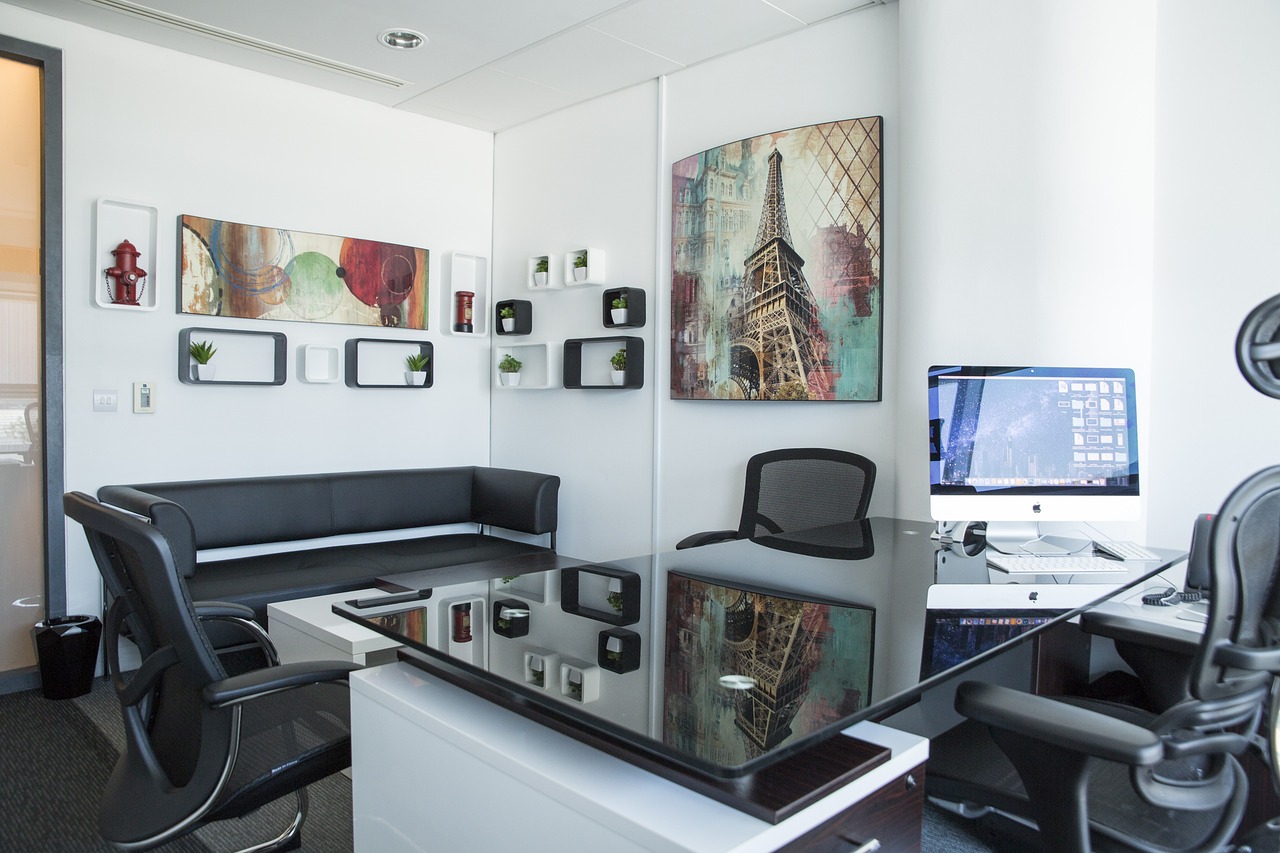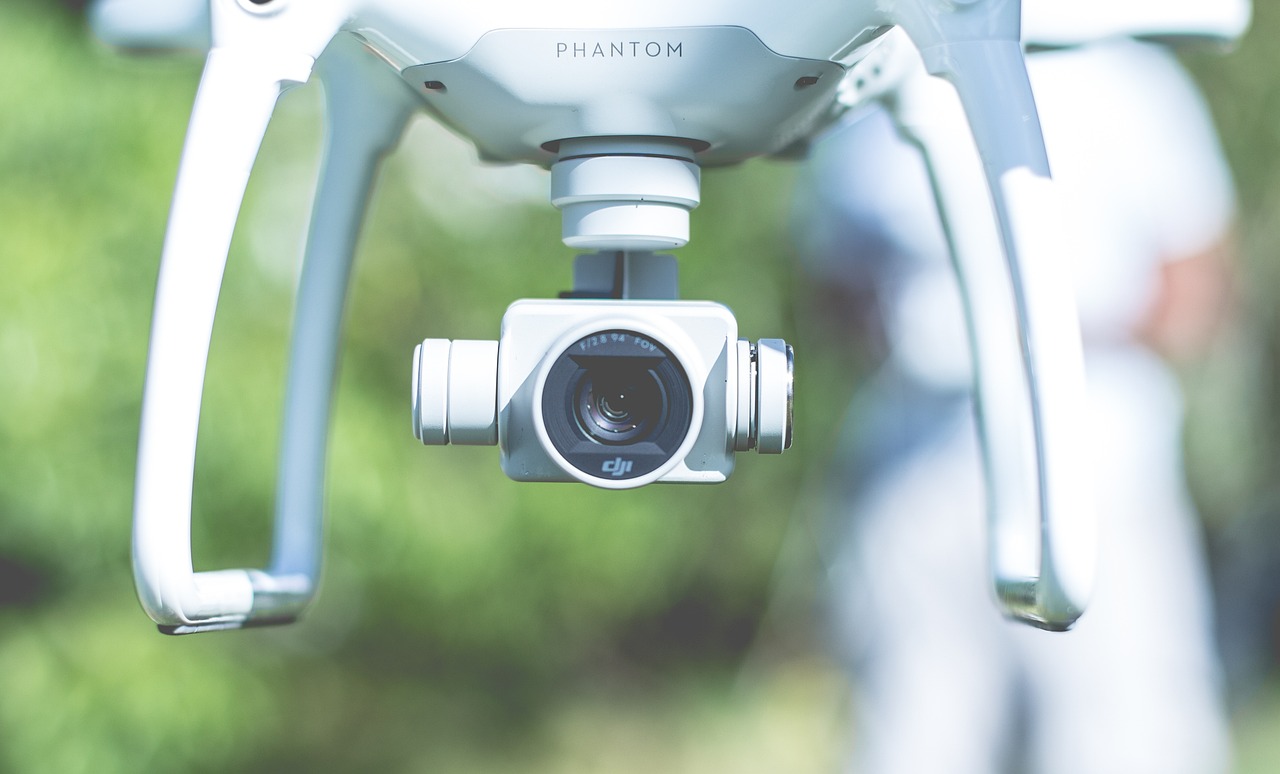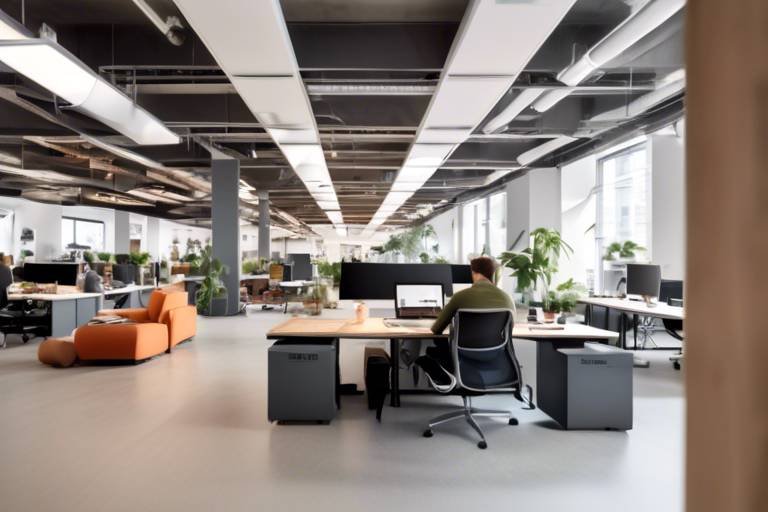The Impact of Remote Work on Office Spaces
In recent years, the landscape of work has undergone a seismic shift, with remote work becoming not just a trend, but a fundamental change in how we approach our jobs. The traditional office, once the epicenter of productivity and collaboration, is now being redefined. This transformation is not merely about swapping a desk for a home office; it’s about reshaping our entire understanding of what an office space should be. With more employees working remotely than ever before, businesses are forced to rethink their office environments, leading to innovative designs and functionalities that cater to a more flexible workforce.
Imagine walking into an office that feels less like a sterile cubicle farm and more like a vibrant community hub. This is the new wave of office spaces that prioritize collaboration, creativity, and comfort. Companies are now focusing on creating environments that foster teamwork while also accommodating the diverse work styles that come with remote arrangements. The result? Open spaces filled with multifunctional areas designed to spark interaction and collaboration, while also providing quiet zones for those moments when concentration is key.
But it’s not just about aesthetics; the implications of remote work extend deeply into the financial realm as well. Organizations are reevaluating their real estate needs, leading to significant cost savings. By downsizing their physical spaces, they can redirect funds towards enhancing technology and investing in employee well-being initiatives. This shift in focus can create a more sustainable business model that not only benefits the bottom line but also enhances employee satisfaction and productivity.
As we delve into the various aspects of this transformation, we will explore how the rise of remote work has altered office design, influenced cost implications for businesses, and integrated technology into our daily work lives. The conversation around the future of office spaces is not just about reducing square footage; it’s about creating environments that are adaptive, inclusive, and forward-thinking.
- How has remote work changed office design?
Remote work has led to more open and flexible office layouts that encourage collaboration while accommodating various work styles.
- What are the cost implications of remote work for businesses?
Companies are saving money by downsizing their office spaces and reallocating budgets towards technology and employee wellness.
- What role does technology play in modern office spaces?
Technology is essential for enhancing communication and collaboration, reshaping how office spaces are utilized.
- What does the future hold for office spaces?
The future will likely prioritize flexibility and employee-centric designs that adapt to evolving work patterns.

Changing Office Design
The rise of remote work has dramatically reshaped the landscape of traditional office design. As more companies embrace flexible work arrangements, the need for conventional cubicles and closed-door offices has diminished. Instead, organizations are leaning towards creating environments that foster collaboration and adaptability. Imagine walking into an office that feels less like a rigid workspace and more like a vibrant community hub—this is the future of office design!
One of the key changes in office layouts is the incorporation of open spaces. These areas encourage spontaneous interactions among employees, sparking creativity and innovation. Instead of being confined to their desks, employees can engage in discussions in shared lounges or collaborative zones. This not only enhances teamwork but also cultivates a sense of belonging among staff. Furthermore, multifunctional areas are becoming increasingly popular. These spaces can serve various purposes, from hosting team meetings to accommodating social events, making the office a dynamic environment.
However, the transition to open spaces is not without its challenges. Noise and distractions can become significant issues in a more open layout. To combat this, many companies are integrating soundproof booths and quiet zones where employees can retreat for focused work. It's all about striking a balance between collaboration and concentration. The design must cater to diverse work styles, ensuring that every employee can find a space that suits their needs.
Another fascinating trend is the incorporation of biophilic design, which emphasizes the connection between humans and nature. Offices are now featuring more natural light, indoor plants, and even living walls. These elements not only beautify the workspace but also contribute to employee well-being, reducing stress and boosting productivity. After all, who wouldn’t feel more motivated working in a space that feels alive and invigorating?
In summary, the changing office design reflects a broader shift in how we perceive work. Companies are recognizing that a well-designed workspace can significantly impact employee satisfaction and performance. As we move forward, we can expect to see even more innovative designs that prioritize flexibility and collaboration, ultimately transforming the way we work.

Cost Implications for Businesses
The rise of remote work has significantly reshaped the financial landscape for many organizations. With employees no longer tethered to a traditional office setting, companies are taking a hard look at their real estate expenditures. This has led to a wave of cost-saving measures and strategic reallocations of funds. Imagine being able to redirect your budget from maintaining a sprawling office space to investing in your employees' well-being or cutting-edge technology. Sounds appealing, right?
One of the most immediate changes organizations are experiencing is the reduced space requirements. With fewer employees physically present in the office each day, many companies are opting to downsize their office footprints. This not only leads to significant savings on rent and utilities but also allows for a more efficient use of resources. For instance, a company that previously occupied a 10,000 square foot office might find that a 5,000 square foot space suffices, cutting costs in half!
Additionally, the rise of shared workspaces is becoming a popular solution. By adopting a shared workspace model, businesses can optimize their office layouts, incorporating collaborative areas that encourage teamwork while minimizing unused space. This not only fosters a vibrant work culture but also allows for a more dynamic use of the office environment. Consider this: instead of having rows of empty desks, companies can create inviting spaces where employees can come together, brainstorm, and innovate.
Moreover, the implementation of hybrid work models plays a crucial role in this transformation. By allowing employees to split their time between home and the office, organizations can create flexible schedules that cater to individual preferences. This flexibility not only enhances employee satisfaction but also reduces the need for extensive office space. Picture a scenario where employees choose to work from home a few days a week; this leads to fewer people in the office on any given day, allowing companies to operate efficiently with a smaller footprint.
However, it’s not just about cutting costs; it’s equally about investing wisely. Companies are reallocating funds toward technology and employee well-being initiatives. This shift is vital in ensuring that employees remain engaged and productive, regardless of where they are working. For example, investing in ergonomic office furniture or wellness programs can significantly boost morale and productivity, resulting in a happier, healthier workforce.
In summary, the cost implications of remote work are profound and multifaceted. By reevaluating their real estate needs, organizations are not only achieving substantial cost savings but are also reallocating resources towards initiatives that enhance employee satisfaction and productivity. This new approach doesn't just benefit the bottom line; it fosters a workplace culture that values flexibility and well-being, creating a win-win scenario for both businesses and employees.
- How can companies effectively downsize their office space? Companies can start by evaluating their current space usage and employee attendance patterns, then consider moving to a smaller, more flexible office layout.
- What are the benefits of shared workspaces? Shared workspaces encourage collaboration, reduce costs associated with unused office space, and create a more dynamic work environment.
- How do hybrid work models affect employee productivity? Hybrid work models can enhance productivity by allowing employees to work in environments where they feel most comfortable and focused, whether at home or in the office.

Reduced Space Requirements
The shift towards remote work has fundamentally altered how companies perceive their office space needs. With a significant number of employees working from home, businesses are discovering that they can operate effectively with fewer desks and meeting rooms. This realization has led to a dramatic reduction in space requirements, enabling organizations to optimize their physical footprint while still maintaining productivity and collaboration among team members.
Imagine a bustling office filled with rows of empty desks, a silent testament to the fact that many employees are now choosing to work remotely. Companies are beginning to question the necessity of maintaining large office spaces. By downsizing, they can not only reduce their overhead costs but also reallocate those funds towards more pressing needs, such as technology upgrades or employee wellness programs. This shift is akin to a homeowner deciding to downsize to a cozier, more manageable space—sometimes less is indeed more.
Furthermore, the reduction in space requirements isn't just about cutting costs; it’s also about creating a more efficient work environment. When fewer employees are physically present in the office, companies can implement more flexible layouts that encourage collaboration and creativity. For instance, instead of traditional cubicles, offices can be designed with open spaces that allow for spontaneous meetings and brainstorming sessions. This not only fosters a sense of community but also maximizes the use of available space.
To illustrate the potential savings and efficiencies gained from reduced office space, consider the following table:
| Aspect | Before Remote Work | After Remote Work |
|---|---|---|
| Average Office Size | 10,000 sq. ft. | 6,000 sq. ft. |
| Employee Count | 100 | 50 (with hybrid model) |
| Monthly Rent | $20,000 | $12,000 |
| Annual Savings | N/A | $96,000 |
As shown in the table, the financial benefits of downsizing can be substantial. Companies can save thousands annually while fostering an environment that promotes flexibility and adaptability. This new approach not only aligns with the modern workforce's preferences but also allows businesses to invest in their employees' well-being and technological advancements, ultimately leading to a more productive and satisfied workforce.
In conclusion, the transition to remote work has opened up a world of possibilities for companies to rethink their office space requirements. By embracing reduced space needs, organizations can create a dynamic work environment that prioritizes collaboration, efficiency, and employee satisfaction while simultaneously cutting costs. It's a win-win situation that reflects the evolving nature of work in today's society.
- What are the benefits of reducing office space? Reducing office space can lead to significant cost savings, improved collaboration, and a more flexible work environment.
- How can companies ensure productivity with less office space? By adopting hybrid work models and utilizing technology for communication and collaboration, companies can maintain productivity even with reduced office space.
- What is the future of office spaces? The future of office spaces will likely prioritize flexibility, collaboration, and employee-centric designs that adapt to changing work patterns.

Shared Workspaces
As the world embraces the concept of remote work, the emergence of has become a game-changer for businesses. Imagine walking into an office where collaboration is not just encouraged but is a natural part of the atmosphere. Shared workspaces provide that environment, allowing employees to come together in a setting designed for flexibility and teamwork. These spaces are not just about desks and chairs; they are about creating a culture that fosters interaction and innovation.
One of the most significant benefits of shared workspaces is their ability to optimize the use of office space. Instead of each employee having a designated desk, shared workspaces allow for a more dynamic approach. Employees can choose where they want to work based on their tasks for the day. This flexibility not only enhances productivity but also reduces the amount of unused space in the office. For instance, a company with 100 employees might only need enough desks for 60, as many employees will be working remotely or on flexible schedules.
Moreover, shared workspaces encourage a sense of community among employees. When people from different teams and departments share the same space, it opens up opportunities for spontaneous conversations and collaborations that might not happen in a traditional office setup. This kind of interaction can lead to innovative ideas and solutions that benefit the entire organization. Think of it as a melting pot of creativity, where diverse thoughts and perspectives come together to spark new initiatives.
However, implementing shared workspaces requires careful planning. Companies need to consider factors such as acoustic privacy, ergonomics, and accessibility. It’s vital to strike a balance between open areas for collaboration and quiet zones for focused work. Additionally, organizations must invest in technology that supports this model, such as booking systems for desks and meeting rooms, to ensure that employees can easily find and utilize the space they need.
In conclusion, the shift toward shared workspaces is not just a trend; it’s a reflection of the changing dynamics of the modern workplace. As businesses continue to adapt to remote work, embracing shared spaces can lead to greater efficiency, enhanced collaboration, and a more engaged workforce. By fostering an environment that encourages teamwork and flexibility, companies can thrive in this new era of work.
- What are shared workspaces? Shared workspaces are collaborative environments where employees from different teams or organizations can work together in a flexible setting.
- How do shared workspaces benefit companies? They optimize space usage, promote collaboration, and can reduce overhead costs associated with traditional office setups.
- Are shared workspaces suitable for all types of businesses? While they can benefit many organizations, companies with specific privacy or security needs may need to consider their unique requirements before adopting this model.

Hybrid Work Models
The concept of has taken the corporate world by storm, and for good reason! Imagine a workplace that offers the best of both worlds: the flexibility of remote work combined with the benefits of in-person collaboration. This approach allows employees to choose when and where they work, fostering a sense of autonomy that can lead to increased job satisfaction and productivity.
In a hybrid work model, organizations typically establish a framework where employees can split their time between the office and their home. This flexibility not only caters to individual preferences but also aligns with the varying needs of different teams. For instance, some departments may thrive on face-to-face interactions, while others might excel in quieter, more focused environments at home. The key is to create a balance that supports both collaboration and concentration.
Many companies are now adopting structured schedules that define which days employees are expected in the office and which days they can work remotely. This not only helps in managing office capacity but also ensures that teams can plan collaborative sessions effectively. For example, a company might designate Tuesday and Thursday as in-office days, encouraging team meetings and brainstorming sessions on those days, while allowing employees to work from home on the other days to focus on individual tasks.
Moreover, hybrid work models can lead to significant cost savings for businesses. With fewer employees in the office at any given time, companies can reduce their real estate footprint, leading to lower rent and utility expenses. This shift allows organizations to reallocate funds towards enhancing employee experiences, such as investing in technology or wellness programs.
However, implementing a successful hybrid work model requires careful planning and consideration. Companies must invest in the right technology to facilitate seamless communication and collaboration. Virtual meeting tools, project management software, and cloud-based platforms become essential to ensure that remote employees feel just as connected and engaged as their in-office counterparts. A well-thought-out strategy can help mitigate challenges such as feelings of isolation or miscommunication.
In summary, hybrid work models are not just a trend; they represent a fundamental shift in how we think about work. By embracing flexibility and prioritizing employee preferences, organizations can create a dynamic workplace that adapts to the evolving landscape of work. As we move forward, it will be fascinating to see how these models continue to develop and shape the future of office spaces.
- What is a hybrid work model? A hybrid work model is a flexible work arrangement that allows employees to split their time between working in the office and working remotely.
- What are the benefits of hybrid work? Benefits include increased flexibility, improved work-life balance, cost savings for businesses, and enhanced employee satisfaction and productivity.
- How can companies implement a hybrid work model? Companies can implement a hybrid work model by establishing structured schedules, investing in technology for communication, and fostering a culture of collaboration.

Employee Well-Being
In recent years, the concept of has taken center stage in the corporate world, particularly as remote work becomes a norm rather than an exception. Companies are realizing that a happy employee is not just a productive one, but also a loyal one. With the shift towards remote work, organizations have been compelled to rethink how they approach employee health and well-being, leading to innovative changes in office design and culture.
One significant transformation is the inclusion of wellness areas within office spaces. These are not just your run-of-the-mill break rooms; they are thoughtfully designed environments that encourage relaxation, mindfulness, and social interaction. Imagine a cozy nook filled with plants, soft lighting, and comfortable seating where employees can unwind or engage in casual conversations. This shift is akin to turning an ordinary house into a home—it's about creating a space that nurtures and supports the people within it.
Moreover, organizations are increasingly recognizing the importance of work-life balance. The flexibility of remote work allows employees to manage their time better, reducing stress and increasing job satisfaction. Companies are now offering mental health days, flexible hours, and even fitness programs to promote a healthier lifestyle. This proactive approach not only enhances morale but also fosters a culture of trust and respect. Employees feel valued when their well-being is prioritized, which in turn boosts overall productivity.
To further illustrate this evolving focus on employee well-being, consider the following table that outlines some common initiatives companies are implementing:
| Initiative | Description |
|---|---|
| Mental Health Days | Paid days off specifically for mental health, allowing employees to recharge. |
| Flexible Work Hours | Options for employees to choose their work hours to better fit their personal lives. |
| Health and Wellness Programs | Programs that promote physical health, including gym memberships and wellness challenges. |
| Mindfulness and Meditation Spaces | Designated areas in the office for relaxation and mindfulness practices. |
Additionally, the rise of remote work has led to a greater emphasis on virtual wellness initiatives. Employers are now investing in online resources such as mental health apps, virtual fitness classes, and wellness webinars. These resources not only support employees working from home but also foster a sense of community among remote teams. It’s like having a gym buddy, but instead, you’re sharing tips and encouragement through a screen.
Ultimately, prioritizing employee well-being is not just a trend; it’s a necessity for modern organizations. As we continue to adapt to new work environments, the focus on health and happiness will only grow stronger. Companies that invest in their employees’ well-being are likely to see a ripple effect—enhanced productivity, lower turnover rates, and a more positive workplace culture. So, as we move forward into this new era of work, let’s remember that a thriving workforce is built on the foundation of well-being.
- What are some benefits of focusing on employee well-being?
Focusing on employee well-being can lead to increased productivity, lower absenteeism, and higher employee satisfaction. - How can companies promote mental health in the workplace?
Companies can promote mental health by offering mental health days, access to counseling services, and creating a supportive work environment. - What role does remote work play in employee well-being?
Remote work allows for greater flexibility, which can help employees manage their time better and reduce stress.

Technology Integration
The rise of remote work has not only changed where we work but also how we work. As businesses adapt to this new landscape, has become a key player in reshaping office spaces. Companies are investing heavily in advanced tools and platforms that facilitate communication, enhance collaboration, and boost overall productivity. This shift is not merely about replacing old tools; it’s about creating a cohesive environment that supports a hybrid work model, where employees can thrive both in the office and remotely.
One of the most significant changes is the adoption of virtual collaboration tools. Platforms like Zoom, Microsoft Teams, and Slack have become household names, enabling teams to connect effortlessly, regardless of their physical location. Imagine being able to brainstorm ideas with colleagues from different corners of the world as if you were all sitting in the same room! This level of connectivity diminishes the need for traditional meeting spaces, allowing businesses to rethink their office layouts. Instead of rows of conference rooms, companies are opting for open areas that encourage spontaneous discussions and creativity.
Moreover, the integration of smart office solutions is revolutionizing the employee experience. These technologies streamline operations, making it easier for employees to navigate their work environment. For instance, smart lighting and climate control systems can adjust automatically based on occupancy, leading to energy savings and a more comfortable workspace. Additionally, IoT (Internet of Things) devices can track space utilization, providing valuable insights that help organizations optimize their office layouts. This data-driven approach allows companies to create a workspace that not only meets the needs of their employees but also aligns with their business goals.
As we look to the future, it’s clear that the integration of technology in office spaces will continue to evolve. Businesses will need to remain agile, adapting to new tools and trends that emerge in the ever-changing landscape of work. From virtual reality meeting rooms to AI-driven project management tools, the possibilities are endless. The key will be to strike a balance between leveraging technology and maintaining a human touch in the workplace. After all, while technology can enhance our work experience, it’s the connections we make with our colleagues that truly matter.
In conclusion, technology integration is not just an option; it’s a necessity for businesses looking to thrive in the modern work environment. By embracing these advancements, organizations can create office spaces that are not only functional but also foster collaboration, innovation, and employee satisfaction.
- What are virtual collaboration tools?
These are software platforms that facilitate communication and collaboration among team members, regardless of their physical location. Examples include Zoom, Microsoft Teams, and Slack.
- How do smart office solutions benefit businesses?
Smart office solutions can enhance energy efficiency, improve employee comfort, and provide valuable data on space utilization, leading to better decision-making regarding office layouts.
- Will technology replace the need for physical office spaces?
While technology can reduce the need for traditional office spaces, it is unlikely to completely replace them. Many businesses will continue to value in-person interactions and collaboration.

Virtual Collaboration Tools
In today's fast-paced digital landscape, have become the backbone of remote work environments. These tools not only facilitate communication but also enhance teamwork, making it possible for individuals to collaborate seamlessly, regardless of their physical location. Think of them as the digital glue that holds remote teams together, allowing ideas to flow freely and projects to progress smoothly.
Imagine being in a meeting where half the participants are in a conference room while others are scattered across different continents. With the right virtual collaboration tools, this scenario becomes not just feasible but incredibly efficient. Tools like Zoom, Microsoft Teams, and Slack have revolutionized how we interact, providing platforms for video conferencing, instant messaging, and file sharing. These tools allow teams to stay connected, share updates, and brainstorm ideas in real-time, making distance feel irrelevant.
Moreover, the integration of features such as screen sharing and collaborative document editing means that teams can work on projects simultaneously, breaking down the barriers of traditional office settings. For instance, using Google Docs, multiple team members can edit a document at the same time, seeing each other's changes in real-time. This not only speeds up the workflow but also fosters a sense of community among remote workers, as they can contribute and see their input valued instantly.
To better understand the impact and advantages of these tools, here’s a quick comparison table highlighting some popular virtual collaboration tools and their key features:
| Tool | Key Features | Best For |
|---|---|---|
| Zoom | Video conferencing, webinar hosting, breakout rooms | Large meetings and webinars |
| Microsoft Teams | Chat, video calls, file sharing, integration with Office 365 | Teams already using Microsoft products |
| Slack | Instant messaging, channels, integrations with other apps | Real-time communication and project management |
The beauty of these tools lies in their ability to adapt to various work styles and preferences. For instance, some team members may prefer to communicate via chat, while others thrive in video discussions. By offering multiple avenues for interaction, virtual collaboration tools cater to diverse needs, ensuring that everyone can engage in a way that feels comfortable and productive.
As businesses continue to embrace remote work, investing in the right virtual collaboration tools becomes crucial. Not only do they enhance productivity, but they also help in building a strong company culture, even from a distance. After all, when team members feel connected and valued, they are more likely to contribute positively to the organization.
In conclusion, virtual collaboration tools are not just a trend; they are essential components of the modern workplace. They empower teams to work together effectively, regardless of where they are located, making remote work not only possible but also enjoyable. As we move forward, embracing these tools will be key to fostering innovation and maintaining strong connections within teams.

Smart Office Solutions
The concept of is revolutionizing the way we think about workspace efficiency and employee experience. Imagine walking into an office where the lights adjust to your presence, the temperature is just right, and your preferred workspace is ready for you—all without lifting a finger. This is the reality that smart office technologies are creating. These solutions not only streamline operations but also enhance the overall atmosphere of the workplace, making it more conducive to productivity and collaboration.
At the core of smart office solutions are technologies that leverage the Internet of Things (IoT), artificial intelligence (AI), and data analytics to optimize office environments. For instance, smart sensors can monitor occupancy levels and adjust lighting and climate control accordingly, ensuring that resources are used efficiently and reducing energy costs. This kind of adaptability is especially crucial in a hybrid work environment, where the number of employees in the office can vary significantly from day to day.
Moreover, smart office solutions facilitate seamless communication and collaboration among team members, regardless of their physical location. Virtual meeting rooms equipped with high-definition video conferencing tools allow for face-to-face interactions, making remote work feel less isolating. Employees can easily share documents and collaborate on projects in real-time, thanks to integrated platforms that bring together various tools into a single interface. This integration reduces the need for traditional meeting spaces, as teams can connect from anywhere, fostering a culture of flexibility and responsiveness.
Another significant benefit of smart office solutions is the ability to gather and analyze data on employee behavior and workspace utilization. By understanding how people interact with their environment, organizations can make informed decisions about office design and resource allocation. For example, if data shows that certain areas of the office are rarely used, businesses can consider repurposing that space for more collaborative functions or even downsizing their physical footprint. This leads to a more efficient use of resources and can result in substantial cost savings.
To illustrate the impact of smart office solutions, consider the following table:
| Smart Technology | Benefits |
|---|---|
| Smart Lighting | Adjusts based on occupancy, reducing energy costs. |
| Climate Control Systems | Maintains optimal temperature, enhancing comfort. |
| Collaborative Software | Facilitates real-time communication and project management. |
| Data Analytics Tools | Provides insights into workspace utilization and employee preferences. |
In conclusion, the integration of smart office solutions is not just a trend but a necessary evolution in the modern workplace. As companies continue to embrace remote and hybrid work models, these technologies will play a pivotal role in shaping flexible, efficient, and employee-centric office environments. By investing in smart solutions, organizations can create spaces that not only meet the needs of their workforce but also foster innovation and collaboration.
- What are smart office solutions? Smart office solutions refer to a range of technologies designed to enhance the efficiency and experience of workspaces through automation, data analytics, and IoT integration.
- How do smart office solutions benefit employees? They improve comfort, enhance collaboration, and provide a more flexible working environment, ultimately leading to increased productivity and job satisfaction.
- Can smart office technologies help reduce costs? Yes, by optimizing resource use and improving energy efficiency, smart technologies can lead to significant cost savings for businesses.
- Are smart office solutions suitable for all types of businesses? While they can be beneficial for many organizations, the implementation should be tailored to fit the specific needs and culture of the business.

Future of Office Spaces
The future of office spaces is poised for a remarkable transformation, reflecting the profound changes brought about by the rise of remote work. As companies adapt to new ways of working, the traditional office layout is evolving into something far more dynamic and flexible. Imagine walking into an office that feels less like a rigid workspace and more like a vibrant community hub! This shift is not just about aesthetics; it’s about creating environments that foster collaboration, innovation, and employee satisfaction.
One of the most significant trends we can expect to see is the emphasis on flexibility. With hybrid work models becoming the norm, office spaces will need to be designed to accommodate a fluctuating number of employees each day. This means that areas will be reimagined to allow for both collaborative teamwork and individual focus. For instance, think about incorporating modular furniture that can be easily rearranged, or creating zones dedicated to different work styles—whether that's quiet nooks for concentration or open areas for brainstorming sessions.
Moreover, the future office will likely embrace technology integration in ways we’ve only begun to explore. Smart office solutions will not only enhance operational efficiency but also create a more engaging experience for employees. Imagine a workspace where you can seamlessly book meeting rooms via an app, adjust lighting and temperature to suit your preferences, or even receive reminders about upcoming team collaborations! The integration of Internet of Things (IoT) devices will allow for a more personalized and responsive office environment, making work not just productive but also enjoyable.
In addition, the focus on employee well-being will take center stage. Companies are realizing that a happy employee is a productive employee, and this realization will shape office designs significantly. Expect to see more wellness areas, such as meditation rooms, fitness zones, and even outdoor spaces that promote a healthy work-life balance. These spaces will not only provide employees with a chance to recharge but will also foster a culture of health and wellness within the organization.
Finally, as we look toward the future, it’s essential to recognize the importance of community and collaboration. The office will no longer be just a place to complete tasks but will evolve into a space where relationships are built and ideas are exchanged. This shift will encourage companies to create environments that facilitate social interaction, whether through communal kitchens, lounge areas, or collaborative workspaces designed specifically for group projects. The goal is to cultivate a sense of belonging, making employees excited to come to the office.
In conclusion, the future of office spaces is bright and full of possibilities. As organizations embrace flexibility, technology, employee well-being, and collaboration, they will create environments that not only meet the needs of their workforce but also inspire creativity and innovation. The office of tomorrow is not just a place to work; it's a place to thrive!
- What will the office of the future look like? The office of the future will likely be flexible, technology-driven, and focused on employee well-being, featuring collaborative spaces and areas for relaxation.
- How will technology change office spaces? Technology will streamline operations, enhance communication, and create a more personalized experience for employees, making work more efficient and enjoyable.
- Why is employee well-being important in office design? Prioritizing employee well-being fosters a positive work environment, leading to increased productivity, job satisfaction, and overall health.
- What role does collaboration play in the future of work? Collaboration will be crucial as businesses shift towards hybrid models, encouraging teamwork and innovation through thoughtfully designed spaces.
Frequently Asked Questions
- How has remote work changed office design?
The shift to remote work has led to more open and multifunctional office spaces. Companies are now designing offices that encourage collaboration while accommodating flexible work styles. This means fewer cubicles and more areas where employees can gather, brainstorm, and innovate together.
- What are the cost implications of remote work for businesses?
Many organizations are reevaluating their real estate needs due to remote work, resulting in significant cost savings. By downsizing their physical office spaces, businesses can reduce overhead costs and redirect budgets towards technology and employee well-being initiatives, creating a more balanced work environment.
- What are shared workspaces, and how do they benefit companies?
Shared workspaces are collaborative areas that allow multiple teams or businesses to use the same office space. This arrangement optimizes the office footprint, minimizes unused space, and fosters collaboration among different teams, making it a cost-effective solution for many organizations.
- How do hybrid work models function?
Hybrid work models combine in-office and remote work, allowing employees to choose their schedules based on personal preferences. This flexibility not only boosts morale but also helps companies attract and retain talent by catering to diverse work styles.
- What role does technology play in the new office environment?
Technology is at the heart of the modern office, especially with the rise of remote work. Businesses are investing in virtual collaboration tools that enable seamless communication and collaboration, regardless of physical location. This shift reduces the need for traditional meeting spaces and enhances overall productivity.
- What are smart office solutions?
Smart office solutions involve integrating technology to streamline operations and enhance employee experiences. These technologies help optimize the use of office space and resources, making it easier for teams to collaborate and work efficiently in a hybrid environment.
- What does the future hold for office spaces?
The future of office spaces is likely to be shaped by the lessons learned during the remote work era. Expect to see designs that prioritize flexibility, collaboration, and employee-centric features, adapting to the evolving needs of the workforce as remote and hybrid models become the norm.



















